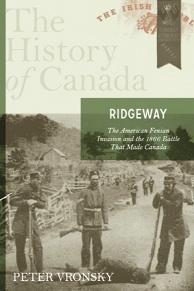Ridgeway: the American Fenian invasion and the 1866 battle that made Canada
Published in 18th–19th - Century History, Irish Republican Brotherhood / Fenians, Issue 4 (July/August 2012), Reviews, Volume 20
Ridgeway: the American Fenian invasion and the 1866 battle that made Canada
Peter Vronsky
(Allen Lane Canada, CDN$34)
ISBN 9780670068036
At 2am on Friday 1 June 1866, Colonel John O’Neill led a Fenian army across the Niagara River to invade Canada. Tactically O’Neill was triumphant; strategically, however, everything went wrong. The assault was supposed to have been but one prong of three; the others never occurred. After winning the Battle of Ridgeway and a street fight in Fort Erie, O’Neill was cut off, without reinforcements or munitions, by the American government’s decision to enforce the Neutrality Act.
Peter Vronsky’s purpose is to reclaim the battle of Ridgeway as the founding moment not only of Canada’s military but also of the country itself. To do so, however, he deploys some curiously tortuous arguments: ‘Covered up and falsified in a series of inquiries, newspaper editorials, and histories penned by interested parties . . . the Battle of Ridgeway became a blank spot in Canadian history’ (p. 279). Ridgeway, he says, ‘has been forgotten not once but twice’ (p. xxxvi), and ‘Ridgeway is a battle so obscure that even many Canadian historians themselves cannot meet the challenge of identifying, dating or describing it without looking it up’ (p. xxxv). Who are these historians?
We may agree that Ridgeway does not ring many loud bells but it is surely wrong to claim that it has been overlooked or disregarded in Canadian historiography. The context included the end of the American Civil War, international tensions between the British Empire and the United States and the Canadian politics of confederation. From C.P. Stacey through to Bruce Hutchison, J.M.S. Careless and Desmond Morton (to name but a few), the role of the Fenians and their military adventures in Canada as a catalyst for confederation has been a staple, neatly summarised most recently by David Wilson: ‘Far from turning the country into a republic, they actually strengthened the cause of Confederation’ (Thomas D’Arcy McGee, vol. 2, p. 221).
What happened at Ridgeway is straightforward. Disregarding the direct orders of the British commander, an auctioneer from Hamilton named Colonel Alfred Booker marched the combined Canadian militia forces up the road from the railway station at Ridgeway into an ambush laid by O’Neill. The Canadians advanced towards the Fenian skirmishing lines, dug in behind barricades. By the time the Fenians pulled back from their first line, many of the Canadians had run out of ammunition. It is plain from O’Neill’s official report of the battle that the withdrawal was tactical—to draw the Canadians on towards his main force. But then, for reasons that remain obscure to this day, someone yelled ‘cavalry’. Booker ordered his men to form a defensive square and then tried to rescind the order; O’Neill, observing their disarray, ordered a charge. The square collapsed under fire and the militia broke and ran. The mystery is the ‘cavalry’. O’Neill insisted that he only deployed a handful of mounted scouts. But there are also reports of Canadian civilians, on horseback, drawn to the battle as sightseers. In any event, Booker’s original sin of disobedience was compounded by inexperience and confusion.
Vronsky acknowledges that the Fenians were ‘experienced and cool under fire’, ‘highly skilled riflemen’, disciplined survivors of a massively brutal war, but he is not above writing this about the decisive moment when the Canadian ranks broke at Ridgeway:
‘Nothing in the Canadians’ drill, in their officers’ training school curriculum, or in their lives could have prepared them to face a bayonet charge—and certainly not the savage one that the Irish Fenians unleashed. Their charge must have been a fearsome sight and sound, one experienced over two thousand years by dozens of conscript armies facing a wild rebel Celtic charge’ (pp 152–3).
The book recounts the action on the battlefields and in the staging areas in as much detail as the conflicting accounts allow. We meet the officers and some of the men of the Queen’s Own Rifles (Toronto) and the XIII Battalion (Hamilton). Some of these mini-biographies demonstrate a deft hand—the egotism of the militia officers lends itself to pen portraiture. We learn about their background and experience (none at all: many of the militiamen had never fired a live round!), and about their equipment, armaments and travel arrangements (all inadequate: they had no food, no water, not enough ammunition, no maps, no horses). Finally, Vronsky provides a detailed account of the main action at Ridgeway and in Fort Erie, including almost minute-by-minute accounts of the actions of some of the Canadians on the battlefield. In short, we have the story told from the Canadian point of view.
The strength—and central weakness—of the book is its detailed but lopsided account of the battles. Vronsky’s commitment to his two principal concerns—to rescue the ‘forgotten’ Ridgeway from oblivion and to ‘restore’ the reputation of the Canadian militiamen who fought—makes for fascinating frustration. If it takes two to tango, surely a war needs an antagonist as well as a protagonist. Early on, he does provide a useful initial order of battle of the Fenian army, but for the rest of the action he barely mentions any of the Fenian combatants, except O’Neill. The result of Vronsky’s partisanship is almost Ridgeway without the Fenians—the Little Big Horn without the Lakota, all Custer and no Crazy Horse. HI
Michael Quigley is a historian and editor of the newsletter of the Canadian Association for Irish Studies.
















